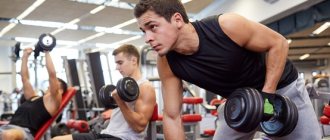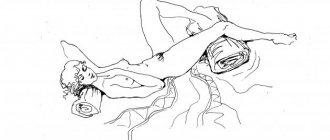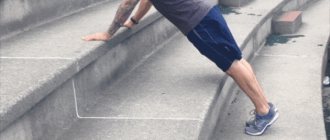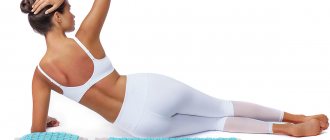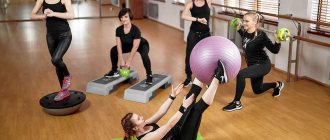Full screen
1 of 6 SLIDES © Provided by: Advertising agency “Index 20” LLC
Exercise No. 1 - “Cat-Dog” (description below)
2 of 6 SLIDES © Provided by: Advertising agency “Index 20” LLC
Exercise No. 2 - “Diagonals” (description below)
3 of 6 SLIDES © Provided by: Advertising agency “Index 20” LLC
Exercise No. 3 (description below)
4 of 6 SLIDES © Provided by: Advertising agency “Index 20” LLC
Exercise No. 4 - “Rear Axle” (description below)
5 of 6 SLIDES © Provided by: Advertising agency “Index 20” LLC
Exercise No. 5 - “Side Plank”
6 of 6 SLIDES © Provided by: Advertising agency “Index 20” LLC
Exercise No. 6 - swing up
6 of 6 SLIDES
Full screen
1 of 1 SLIDES
1 of 1 SLIDES
If you're worried about back pain, sooner or later you'll get an X-ray or MRI. Then you will take a course of medications. And if your case is not yet advanced enough to require surgery, then you will be offered physical therapy. Sounds boring and seems unnecessary and pointless? This is a great misconception. About why only exercise therapy can help you, read the material from Passion.ru and Alexander Kolesov, doctor of exercise therapy and sports medicine at MEDSI.
Back pain: where to start
Back pain is a very collective concept, and there are many different diseases (including internal organs, such as kidneys or heart), one of the symptoms of which is back pain. Therefore, when you first have such complaints, you need to see a doctor so that you can be examined and diagnosed correctly. Most often, this is a neurologist, a traumatologist, or, if the pain is associated with sports, it may be a sports doctor.
When a specialist has looked at you, conducted the necessary examinations and ruled out the possibility of such serious diseases as coronary heart disease, urolithiasis or others, then we can talk about prescribing medication and therapeutic exercises.
No. 2. Pullover with two dumbbells.
The exercise is similar to a regular single dumbbell pullover, but is actually more targeted and provides a significant stretch to the back muscles already in the middle stage of the movement.
You can perform it either across the bench or while lying on the bench, it all depends on your preferences and feelings. In the first option, your chest and chest muscles receive additional stretching. However, be careful with the choice of weight. Excessive weight puts unnecessary strain on your lower back!
If you prefer to do a pullover across the bench, keep your pelvis higher and avoid excessive arching in your lower back. Deflection plus excessive weight can lead to damage
intervertebral discs Intervertebral discs are pads with a spongy structure that act as shock absorbers between each of the vertebrae...
(MORE...)
OUR RECOMMENDATIONS:
Perform eight to fifteen repetitions per set. Slow and controlled. Maintain a slight bend in your elbows throughout the approach, this will provide a good stretch and keep tension in your back muscles, taking it away from your pectoral muscles.
After relieving acute pain
When acute pain is relieved, there are many treatment methods to consolidate the result and finally relieve pain - these are physiotherapy, massage, manual therapy, acupuncture and others. But none of them strengthens our muscles and, therefore, is not preventive, that is, preventing the disease from developing again. Only properly selected therapeutic exercises, posture control, work and rest regime will prevent the development of new exacerbations. This requires regular exercise and gradually increasing the load to the required level.
Improving working time efficiency
Honestly, I don’t know how realistic it is to do such an exercise in the office, but if the work environment in your office allows you to hold the roller that Vyacheslav talks about in this video, then this exercise will definitely benefit you.
It’s not clear how, but in fact, your head begins to work better, and it’s quite possible that thanks to such lateral stretches you can not only improve your productivity, but also improve your well-being and not end up a tired wreck at the end of the working day.
Why exercises “from the Internet” can be dangerous
Complexes of basic exercises, of course, exist, but they always include exercises based on the principle: “do no harm,” because its creator never knows who will decide to perform it, where the patient will see this complex: whether the doctor will advise him, or whether he will download the information from Internet. And as we know, each person is individual in his own way, each has his own characteristics of the structure of the spine, the nuances of work and life.
In addition, problems in the spine are most often associated with either excessive mobility or its limitation, and, therefore, different exercises will be needed. Therefore, only a specialist, after conducting the necessary tests and examinations and making a correct diagnosis, will be able to give you comprehensive recommendations on selecting the exercises you need.
The correctness of the exercises is of great importance, so as not to aggravate the problem, and I always advise you to come back two or three times for a second consultation to check the correctness of the exercises and adjust the set of recommended exercises so that the patient develops motor control and develops the correct movement pattern .
Exercises to unload the spine
This exercise is simple, but it will relieve your spine and improve blood circulation.
Sit up straight, clasp your hands in front of you. As you inhale, raise your arms up, straightening your body and filling it with air.
As you exhale, return to the starting position. And again, as you inhale, stretching out and filling your body with inhalation, raise your arms up and come back as you exhale.
Very soon you will notice that the blood begins to circulate, the spine is unloaded, the body warms up and the general condition becomes much better.
Recommendations for self-study
Of course, if it is not possible to contact a specialist, you can try performing one or another set of exercises, but you need to remember that all exercises must be performed smoothly, without jerking, and they should not cause pain. If pain occurs while performing an exercise, then you need to stop doing it and not endure the pain.
The need for an examination (including x-rays of the spine) before therapeutic exercises will be determined by your attending physician. If you do not have illness or pain, and you want to do gymnastics as a preventive measure, then a special examination is not required, but it is better if, for example, an instructor at a fitness club shows you and monitors the correct execution of the exercise.
And the main rule is that at the beginning of independent training, try to avoid excess load, sudden movements, exercises with weights and jumping.
There are basic exercises that help strengthen the main muscle groups, but we must remember that you should start doing them gradually, gradually increasing the load, and also that for each age the exercises will differ in the direction of easing the load.
It is important to monitor your heart rate so that during exercise it does not exceed 60-70% of the MHR (maximum heart rate = 220 - age).
Aerobic exercise is especially useful (ellipse, Swedish walking, walking on a treadmill, jogging, exercise bike, swimming), it should be performed 2-3 times a week, in a pulse zone of 60-70% of MHR, 5 minutes - warm-up, 25- 40 minutes - work in the pulse zone, 5 minutes - cool down.
Aerobic exercise improves the functioning of the respiratory and cardiovascular systems, increases tissue capillarization, and has a positive effect on the functioning of the endocrine system.
Depending on age and existing diseases, I would classify as basic exercises those that strengthen the back and abdominal muscles, gluteal muscles, and paravertebral muscles in people over 50 years of age. For younger people, it may be more energy-intensive: burpees, pull-ups, push-ups, planks in all its varieties.
An increase in muscle tissue increases overall metabolism and has a positive effect on well-being and overall activity.
General set of exercises
All of the above exercises allow you to relieve stress from the back, activate normal blood circulation, remove clamps from nerve endings, remove swelling, and increase the space between the vertebrae to normalize the intervertebral discs.
Rules for doing the exercises:
- do not exercise during periods of exacerbation of back diseases;
- all movements are performed smoothly;
- if you feel pain after any exercise, you should give it up;
- starting with a minimum number of approaches, gradually increase the load.
Also, any exercises have contraindications. List of contraindications for exercises:
- hypertension, glaucoma;
- heart rhythm disturbances;
- acute inflammatory diseases;
- nervous disorders;
- pathologies of the vestibular apparatus.
Before performing back exercises, consult your doctor, he will help you choose the optimal load regimen.
- Lie on your back, place your arms straight behind your head. Stretch your arms away from your head and your feet away from your body, stretching the thoracic and other parts of the spine. Then pull your toes towards you and reach through your heels.
- While lying on your back, bend your knees. Place your left hand behind your head, move your legs to the right, trying to touch the floor with your knees. The pelvis rotates behind the knees. As you twist, turn your head to the left.
- Wrap your arms around your legs bent at the knees. Pull your knees towards your chest, trying to touch them with your forehead. Stay in this position for 2-3 seconds, relax. Repeat the exercise 3 times.
- Sit down and place your legs bent together in front of you. Grasp your knees with outstretched arms. Bend over so that your stomach touches your knees. Then bend in the opposite direction so that the arch of your back faces outward.
- Sit so that your body forms a right angle and your legs are extended. Stretch your arms up, press your feet to the floor, toes pointing towards your chest, heels pointing forward. Pull your arms up, stretching your thoracic spine, and pull your toes toward you.
- Remaining in the pose from the previous exercise, spread your arms to your sides, rotate your body to the sides following your arms, the pelvis should be motionless.
- Stand with your feet slightly wider than shoulder-width apart. Spread your arms. Bend forward at a right angle and touch the toes of your right foot with the fingers of your left hand. Raise your right hand up, turn your head and look at her fingertips.
- Bend your legs under you, sit on your heels. Place your hands on the floor in front of you, stretch them forward and stretch your body following your hands, do not lift your pelvis from your heels.
- Raise your body from the previous pose so that your legs to your knees are strictly perpendicular to the floor. Bend your body to the floor and stretch your arms forward, stretching your spine.
- This is the final exercise to relax the spinal muscles. Sit on your heels, fold your hands on the floor in front of you, lie with your stomach on your knees and rest your forehead on your folded hands. Hold for 5-10 seconds. At this time, you should feel complete relaxation of your back muscles.
It is advisable to perform all of the above exercises once daily, either in the morning and in the evening.
No. 4. Rowing in the simulator while sitting.
This movement specifically loads the lats, stimulating their growth. It is important to keep your elbows close to your body throughout the exercise, this directs the load specifically to the outer area of the lats, whereas performing with elbows apart only works the middle of the back.
OUR RECOMMENDATIONS:
Try to fully stretch the muscles on each rep. For maximum lat activation, pull the handle straight toward your waist. At the point of contraction, straighten your chest and arch your lower back, without leaning back.
Let's diversify a little
Shavasana can be varied. For example, you can spread your arms to the sides and move them back and forth.
You can strengthen the stretch if you place your arms straight behind your head and stretch into an arrow. In this case, the stretching will become so significant that you may even feel some discomfort.
We get maximum stretching if we place a bolster or rolled up towel under the lower back in the “arrow” position.
Another great home remedy that allows you to maintain a healthy spine in between is a horizontal bar and wall bars. It is enough to hang for just a few seconds, and the spine immediately straightens. And the straightened disk receives more power, the load is removed from it, and as a result it wears out more slowly.
But to practice on the horizontal bar, you need to not have too much weight, otherwise the tendons may not be able to withstand it and become inflamed, and the metal structures may break and cause serious injury. For people with sore arm joints, as well as those with severely elevated blood pressure or other serious chronic diseases, the horizontal bar may be contraindicated.
It is easier to practice on the wall bars than on the horizontal bar. You can simply lean on it and stretch your back. Even those who are highly obese can do this.
No. 5. Dumbbell rows, bent over weights.
Many athletes consider this the best exercise, as it expands and thickens the entire length of the latissimus muscle better than any other. Working with one hand allows you to gain concentration, which will ensure a controlled lifting of the weight with the back muscles, not the biceps.
OUR RECOMMENDATIONS:
Make sure that the muscles are well stretched at the bottom of the exercise and achieve proper contraction at the top. Keep your torso parallel to the floor and pull the dumbbell toward your hip.
The spine is our everything
The spine is, without exaggeration, the basis of human life. Even a slight deterioration in his condition causes, firstly, chronic, debilitating pain, which can drive a person into a frenzy and the desire to stop it at any cost, and secondly, severe disorders in a variety of organs.
This is not surprising, because the spine is not only a support for our body (and we are upright creatures, and therefore our spine experiences extreme loads), but also, in computer language, the most important super tire, carrying information from every organ and every corner body to the brain, and transmitting control signals from the brain. Thus, if a person begins to develop osteochondrosis, then in addition to the obligatory pain syndrome, a real barrage of chronic diseases will hit him in the near future.
The health of the spine must be monitored as closely as dental hygiene. That is, small exercises to unload the discs and strengthen muscles and ligaments should be done every day.
This should be the same habit as the habit of brushing your teeth and washing your face.
